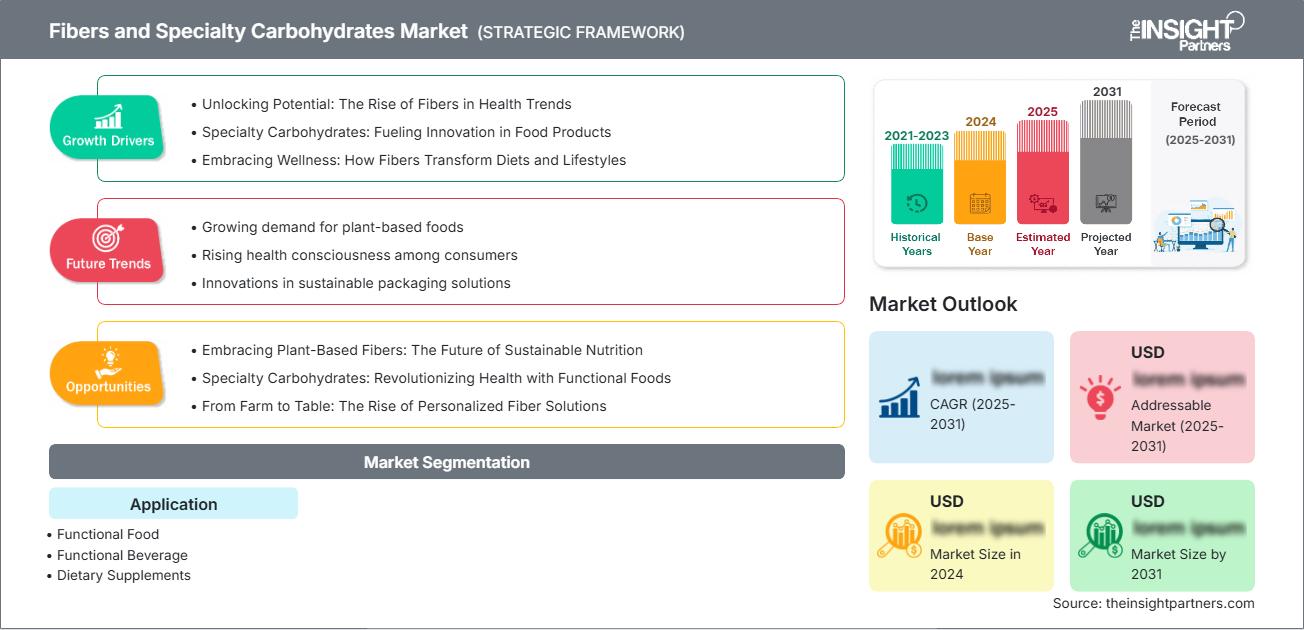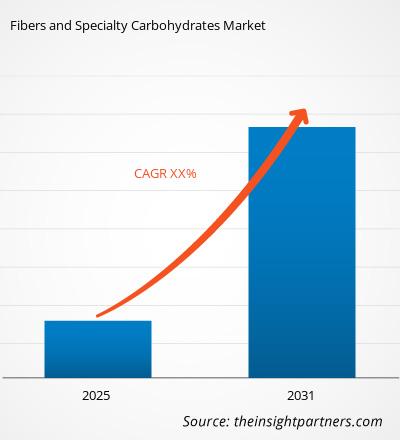INTRODUZIONE AL MERCATO
La fibra è fondamentalmente un tipo di carboidrato che l'uomo non può digerire. Sebbene la maggior parte dei carboidrati venga scomposta in molecole di zucchero, la fibra non può essere scomposta in molecole di zucchero e, invece, passa attraverso l'organismo senza essere digerita. La fibra aiuta a regolare l'uso degli zuccheri da parte dell'organismo, contribuendo a tenere sotto controllo la fame e la glicemia. Le fibre subiscono principalmente una fermentazione parziale o completa nell'intestino crasso. I carboidrati speciali sono definiti nutraceutici derivati da prebiotici e probiotici. Un consumatore che segue diete ricche di fibre può essere immune da malattie come cancro intestinale, diabete, malattie coronariche e altre. I carboidrati speciali sono noti come sostanze complesse preparate da zuccheri semplici, tra cui glucosio, galattosio, acido sialico, L-fucosio e glucosamina. In natura, si trovano principalmente nel latte. Trovano applicazioni in settori come nutraceutici, cosmetici, farmaceutici e prodotti fitosanitari. Le fibre e i carboidrati speciali svolgono un ruolo importante per la salute degli animali e degli esseri umani e sono considerati una fonte vitale di innovazione nei settori del benessere, farmaceutico, biomedico e cosmetico.
DINAMICHE DI MERCATO
Il mercato delle fibre e dei carboidrati speciali ha registrato una crescita significativa grazie a fattori quali la loro più ampia applicazione in alimenti funzionali, bevande funzionali, integratori alimentari, nutrizione animale e cura della persona. Nei paesi in via di sviluppo, tra cui India, Cina, Messico e Medio Oriente, si registra una crescente consapevolezza in materia di salute e benessere tra i consumatori, che sta trainando il mercato delle fibre e degli integratori alimentari. Palestre e centri fitness sono attualmente molto diffusi, il che dovrebbe ulteriormente alimentare la crescita del mercato delle fibre e dei carboidrati speciali. Tuttavia, la crescente domanda di nuovi prodotti, come fitochimici e carotenoidi come ingredienti nutraceutici, grazie alle loro proprietà superiori, tra cui un'eccellente azione antiossidante, potrebbe ostacolare il mercato delle fibre e dei carboidrati speciali. Tuttavia, si prevede che il facile accesso alle materie prime e le prospettive positive per il settore degli alimenti funzionali in molti paesi attireranno gli operatori del settore a investire in questo mercato.
Riceverai la personalizzazione gratuita di qualsiasi report, incluse parti di questo report, analisi a livello nazionale, pacchetto dati Excel e potrai usufruire di fantastiche offerte e sconti per start-up e università.
Mercato delle fibre e dei carboidrati speciali: approfondimenti strategici

-
Scopri le principali tendenze di mercato di questo rapporto.Questo campione GRATUITO includerà analisi dei dati, che spaziano dalle tendenze di mercato alle stime e alle previsioni.
"Fibre e analisi di mercato globali fino al 2031" è uno studio specializzato e approfondito del settore alimentare e delle bevande, con particolare attenzione all'analisi delle tendenze del mercato globale. Il rapporto mira a fornire una panoramica del mercato delle fibre e dei carboidrati speciali, con una segmentazione dettagliata per applicazione e area geografica. Si prevede che il mercato globale delle fibre e dei carboidrati speciali registrerà una crescita elevata durante il periodo di previsione. Il rapporto fornisce statistiche chiave sullo stato di mercato dei principali operatori del settore delle fibre e dei carboidrati speciali e offre tendenze e opportunità chiave.
Approfondimenti regionali sul mercato delle fibre e dei carboidrati speciali
Le tendenze e i fattori regionali che influenzano il mercato delle fibre e dei carboidrati speciali durante il periodo di previsione sono stati ampiamente spiegati dagli analisti di The Insight Partners. Questa sezione illustra anche i segmenti e la distribuzione geografica del mercato delle fibre e dei carboidrati speciali in Nord America, Europa, Asia-Pacifico, Medio Oriente e Africa, America Meridionale e Centrale.
Ambito del rapporto di mercato sulle fibre e sui carboidrati speciali
| Attributo del report | Dettagli |
|---|---|
| Dimensioni del mercato nel 2024 | XX milioni di dollari USA |
| Dimensioni del mercato entro il 2031 | XX milioni di dollari USA |
| CAGR globale (2025 - 2031) | XX% |
| Dati storici | 2021-2023 |
| Periodo di previsione | 2025-2031 |
| Segmenti coperti |
Per applicazione
|
| Regioni e paesi coperti |
America del Nord
|
| Leader di mercato e profili aziendali chiave |
|
Densità degli attori del mercato delle fibre e dei carboidrati speciali: comprendere il suo impatto sulle dinamiche aziendali
Il mercato delle fibre e dei carboidrati speciali è in rapida crescita, trainato dalla crescente domanda da parte degli utenti finali, dovuta a fattori quali l'evoluzione delle preferenze dei consumatori, i progressi tecnologici e una maggiore consapevolezza dei benefici del prodotto. Con l'aumento della domanda, le aziende stanno ampliando la propria offerta, innovando per soddisfare le esigenze dei consumatori e sfruttando le tendenze emergenti, alimentando ulteriormente la crescita del mercato.

- Ottieni una panoramica dei principali attori del mercato delle fibre e dei carboidrati speciali
SEGMENTAZIONE DEL MERCATO
Il mercato globale delle fibre e dei carboidrati speciali è segmentato in base all'applicazione. Il mercato delle fibre e dei carboidrati speciali, in base all'applicazione, è classificato in alimenti funzionali, bevande funzionali, integratori alimentari, nutrizione animale e cura della persona.
QUADRO REGIONALE
Il rapporto fornisce una panoramica dettagliata del settore, includendo informazioni sia qualitative che quantitative. Fornisce una panoramica e una previsione del mercato globale delle fibre e dei carboidrati speciali in base a diversi segmenti. Fornisce inoltre stime sulle dimensioni del mercato e sulle previsioni per il periodo 2021-2031 in relazione a cinque regioni principali: Nord America, Europa, Asia-Pacifico (APAC), Medio Oriente e Africa (MEA) e Sud America. Il mercato delle fibre e dei carboidrati speciali per ciascuna regione viene successivamente suddiviso in sottosegmenti per paese e segmento. Il rapporto include l'analisi e le previsioni di 18 paesi a livello globale, insieme alle tendenze attuali e alle opportunità prevalenti nella regione.
Il rapporto analizza i fattori che influenzano il mercato delle fibre e dei carboidrati speciali sia dal lato della domanda che dell'offerta e valuta ulteriormente le dinamiche di mercato che influenzano il mercato durante il periodo di previsione, ovvero fattori trainanti, vincoli, opportunità e tendenze future. Il rapporto fornisce inoltre un'analisi PEST esaustiva per tutte e cinque le regioni, ovvero: Nord America, Europa, APAC, MEA e Sud America dopo aver valutato i fattori politici, economici, sociali e tecnologici che influenzano il mercato delle fibre e dei carboidrati speciali in queste regioni.
ATTORI DEL MERCATO
I report coprono diversi sviluppi chiave nel mercato globale delle fibre e dei carboidrati speciali. Diverse aziende stanno concentrando le proprie strategie di crescita su lanci di prodotti, approvazioni di prodotti e altre strategie come brevetti ed eventi. Alcune delle attività strategiche di crescita osservate nel mercato sono state acquisizioni, partnership e collaborazioni. Queste attività hanno aperto la strada all'espansione del business e della base clienti degli operatori del mercato. Si prevede che i player del mercato delle fibre e dei carboidrati speciali godranno di opportunità di crescita redditizie in futuro, grazie alla crescente domanda di fibre e carboidrati speciali nel mercato globale. Di seguito è riportato l'elenco di alcune aziende impegnate nel mercato delle fibre e dei carboidrati speciali.
Il report include anche i profili delle aziende chiave, insieme alla loro analisi SWOT e alle strategie di mercato nel mercato delle fibre e dei carboidrati speciali. Inoltre, il report si concentra sui principali operatori del settore con informazioni quali profili aziendali, componenti e servizi offerti, dati finanziari degli ultimi 3 anni e gli sviluppi chiave degli ultimi 5 anni.
- Ajinomoto Inc.
- Archer Daniels Midland Company
- Cargill Incorporated
- DSM NV
- EI Du Pont De Nemours e Compagnia
- FMC Corporation
- Ingredion Incorporated
- J. Rettenmaier & Söhne GmbH & Co. Kg
- Roquette Frères
- Società Südzucker AG
- SunOpta, Inc.
- Tate & Lyle Plc
Il team dedicato alla ricerca e all'analisi di Insight Partner è composto da professionisti esperti con competenze statistiche avanzate e offre diverse opzioni di personalizzazione nello studio esistente.
- Analisi storica (2 anni), anno base, previsione (7 anni) con CAGR
- Analisi PEST e SWOT
- Valore/volume delle dimensioni del mercato - Globale, Regionale, Nazionale
- Industria e panorama competitivo
- Set di dati Excel
Report recenti
Testimonianze
Motivo dell'acquisto
- Processo decisionale informato
- Comprensione delle dinamiche di mercato
- Analisi competitiva
- Analisi dei clienti
- Previsioni di mercato
- Mitigazione del rischio
- Pianificazione strategica
- Giustificazione degli investimenti
- Identificazione dei mercati emergenti
- Miglioramento delle strategie di marketing
- Aumento dell'efficienza operativa
- Allineamento alle tendenze normative






















 Ottieni un campione gratuito per - Mercato delle fibre e dei carboidrati speciali
Ottieni un campione gratuito per - Mercato delle fibre e dei carboidrati speciali